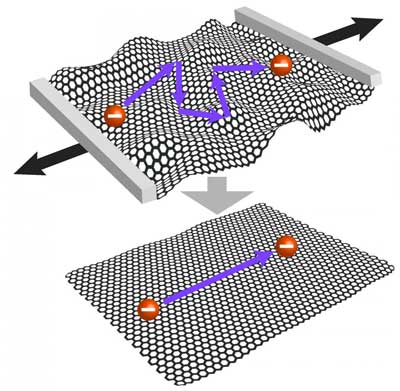| Apr 17, 2020 | |
Flatter graphene, faster electrons(Nanowerk News) Bumps on a road slow down our pace, so do corrugations in graphene to travelling electrons. By flattening the corrugations out, we help electrons move effectively faster through a graphene sheet. |
|
Limits because of microscopic distortions |
|
| The sample quality of graphene has been improved significantly since its discovery. One factor that limited further improvements has not been investigated directly so far, namely corrugations in the graphene sheet, i.e. microscopic distortions that form even when placed on atomically flat surfaces. Such corrugations can scatter the electrons when moving through an electronic device. | |
 |
|
| Corrugations in graphene slow down the pace of travelling electrons. By pulling on the graphene sheet on two opposite sides, it is flattened and smoothed, and electron transport is improved. (Image: Swiss Nanoscience Institute) | |
| The team of professor Christian Schönenberger of the Swiss Nanoscience Institute and Department of Physics at the University of Basel has developed a technique to pull the graphene sheet on two opposite sides and thereby flattening and smoothing it. | |
| "It is similar to pulling on a piece of crumpled paper which irons out wrinkles and folds», says Dr. Lujun Wang, first author of the study (Physics Review Letters, "Mobility Enhancement in Graphene by in situ Reduction of Random Strain Fluctuations"). | |
| "After this process, the electrons travel effectively faster through the graphene sheet, their "mobility" increases, demonstrating an improved sample quality", his supervisor Dr. Andreas Baumgartner adds. | |
| These findings not only help us to further understand the electron transport in graphene but also provide instructions for studying other two-dimensional materials. |
| Source: University of Basel | |
|
Subscribe to a free copy of one of our daily Nanowerk Newsletter Email Digests with a compilation of all of the day's news. |
